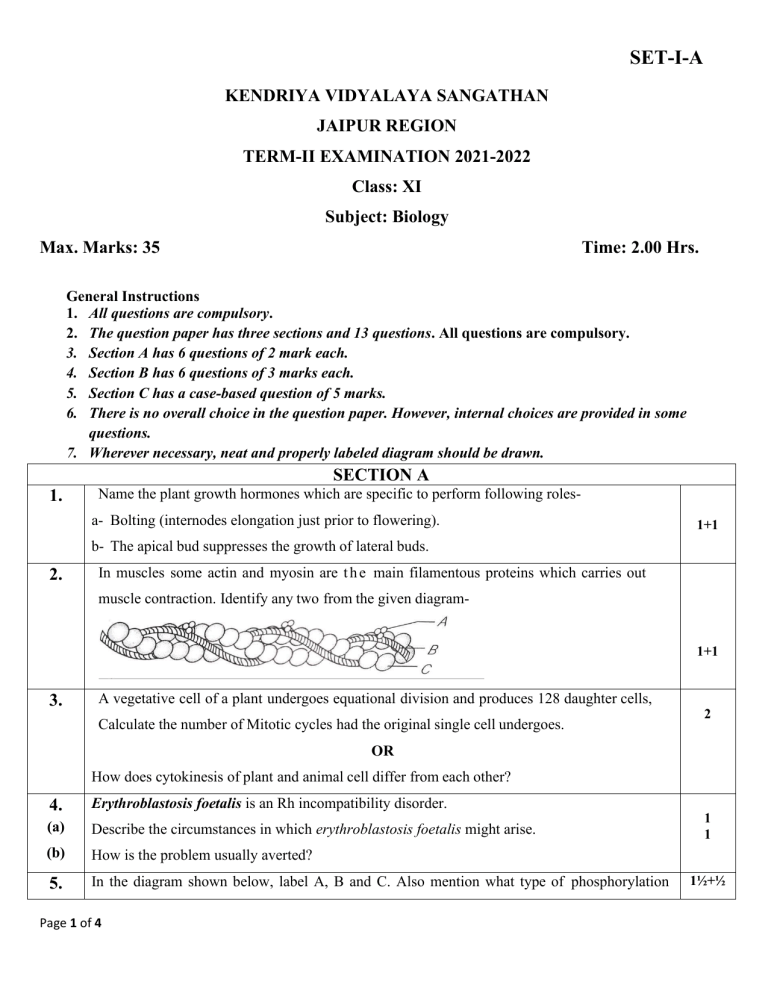
SET-I-A KENDRIYA VIDYALAYA SANGATHAN JAIPUR REGION TERM-II EXAMINATION 2021-2022 Class: XI Subject: Biology Max. Marks: 35 Time: 2.00 Hrs. General Instructions 1. All questions are compulsory. 2. The question paper has three sections and 13 questions. All questions are compulsory. 3. Section A has 6 questions of 2 mark each. 4. Section B has 6 questions of 3 marks each. 5. Section C has a case-based question of 5 marks. 6. There is no overall choice in the question paper. However, internal choices are provided in some questions. 7. Wherever necessary, neat and properly labeled diagram should be drawn. SECTION A 1. Name the plant growth hormones which are specific to perform following rolesa- Bolting (internodes elongation just prior to flowering). 1+1 b- The apical bud suppresses the growth of lateral buds. 2. In muscles some actin and myosin are t h e main filamentous proteins which carries out muscle contraction. Identify any two from the given diagram- 1+1 3. A vegetative cell of a plant undergoes equational division and produces 128 daughter cells, Calculate the number of Mitotic cycles had the original single cell undergoes. 2 OR How does cytokinesis of plant and animal cell differ from each other? 4. Erythroblastosis foetalis is an Rh incompatibility disorder. (a) Describe the circumstances in which erythroblastosis foetalis might arise. (b) How is the problem usually averted? 5. In the diagram shown below, label A, B and C. Also mention what type of phosphorylation Page 1 of 4 1 1 1½+½ SET-I-A is possible in this? 6. What would be the RQ value of yeast if it were to respire glucose anaerobically? OR Pyruvic acid generated in the crystal is transported to mitochondria and initiates the second phase of respiration. Before pyruvic acid enters the Kreb’s cycle, one of its three carbon atoms is oxidized to carbon dioxide inthe reaction called oxidative decarboxylation. (i) Name the enzyme that catalyses the process. 1 (ii) How many NADH is produced during process? 1 SECTION B 7. In the above diagram, comment on the functioning of A, B and C. 8. 1 1 1 List the location in the cell where the following reactions take place during the process of photosynthesis. a) Synthesis of NADPH and ATP b) Photolysis of water 1 1 Page 2 of 4 SET-I-A 1 c) CO2 fixation 9. Explain the factors on which the impulse conduction depends. What is the significance of Saltatory conduction? OR Observe the diagram and label A, B and C. Mention one function of each. 10. 1½+ 1½ What changes occur to cytoplasmic pyruvate under following conditionsa- Anaerobic condition in muscle cells b- Anaerobic condition in presence of yeast 1 1 1 c- Aerobic condition 11. What are the different modes of excretion in animals? Give one example of each. 12. A biology student asked his teacher that why two individuals of same population does not 3 look similar. The teacher told him about the concept of meiosis and crossing over. The teacher also mentioned that meiosis occurs in two stages which differ significantly. (i) When does the crossing over occur in humans and name the type of cells involved 1 in it? (ii) How many daughter cells are produced at the end of meiosis-I and II respectively? 1 (iii) Draw diagrams to show the striking difference between Anaphase-I and Anaphase- 1 II of meiosis. SECTION C (CASE STUDY BASED) 13. Read the paragraph and answer the questions: The hormone is distributed in blood and binds to distant target cells. These chemical messengers control various functions like metabolism, reproduction, growth etc. the hormones may be of various types- Page 3 of 4 SET-I-A Protein hormones (e.g., insulin, glucagon), Steroids (e.g., cortisol, testosterone) etc. Some secondary messengers also help in mechanism of action of hormones. Hormone secretion is regulated by signals from the nervous system, chemical changes in the blood, and effect of other hormones. (a)Endocrine action: the hormone is distributed in blood and binds to distant target cells. (b)Paracrine action: the hormone acts locally by diffusing from its source to target cells in the neighbourhood. (c)Autocrine action: the hormone acts on the same cell that produced it. a- Diagrammatically represent the mechanism of action of peptide hormone(FSH). 3 b- Write any two differences between mechanism of action of protein and steroid 2 hormones. OR Your pituitary gland is about the size of a pea and is situated in a bony hollow, just behind the bridge of your nose. It is attached to the base of your brain by a thin stalk. The pituitary gland is often called the master gland because it controls several other hormone glands in your body, including the thyroid and adrenals, the ovaries and testicles.Together, the hypothalamus and pituitary tell the other endocrine glands in your body to make the hormones that affect and protect every aspect of your health. The pars distalis, pars intermedia and Pars nervosa are various parts of pituitary gland. Answer the following questionsa- What is role of LH and FSH in human female? Page 4 of 4 2 b- What is pituitary dwarfism? Which hormone is responsible for this? 2 c- Which pituitary hormone acts on Kidney? Also mention the role of that hormone. 1




